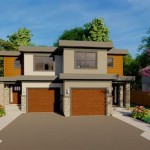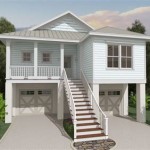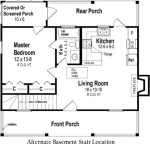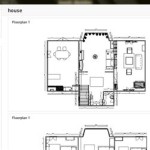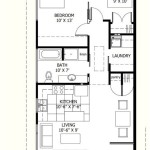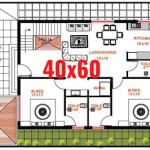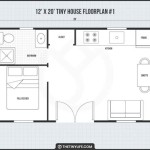House Plans With Garage Underneath: A Comprehensive Overview
Integrating a garage underneath the main living space of a house, often termed a "drive-under garage" or "basement garage," is a design strategy that can offer numerous benefits, particularly on challenging terrains or in areas with specific zoning regulations. The incorporation of this feature significantly impacts the overall architectural design, structural engineering, and practical functionality of a residential property. Understanding the nuances of house plans with a garage underneath is crucial for homeowners, builders, and architects alike.
These types of house plans are frequently employed in sloped landscapes where a conventional attached garage would be difficult or aesthetically unappealing to incorporate. By tucking the garage beneath the dwelling, the natural contours of the land can be better preserved, minimizing site disturbance and potentially reducing excavation costs in certain cases. This design approach also maximizes usable living space on smaller lots, as the garage footprint does not detract from the above-ground area available for other purposes.
Furthermore, houses with garages underneath can present distinct advantages in terms of accessibility and convenience. Direct access from the garage to the main living area, often via a staircase, provides shelter from the elements during inclement weather. This is particularly valuable in regions prone to heavy rain, snow, or extreme temperatures. The under-house garage configuration can also enhance security, as residents can enter and exit their vehicles without being exposed to the outside. However, integrating this type of garage requires careful planning and adherence to specific building codes to ensure safety and structural integrity.
Key Considerations in Design and Construction
The design and construction of a house with a garage underneath presents unique challenges that require careful consideration. Load bearing capacity, drainage, ventilation, and fire safety are critical factors that must be addressed during the planning and construction phases. The structural integrity of the building is paramount, as the main house structure rests upon the garage's foundation and walls. Therefore, robust materials and construction techniques are essential to ensure long-term stability.
Adequate drainage is crucial to prevent water from accumulating around the foundation and potentially damaging the garage structure. This includes proper grading of the surrounding land, installation of effective drainage systems, and waterproofing of the foundation walls. Ventilation is also important to prevent the buildup of moisture and harmful gases, such as carbon monoxide, within the garage. Proper ventilation systems should be installed to ensure adequate air circulation and to mitigate the risk of indoor air quality issues.
Fire safety is another critical consideration. Garages are often used for storing flammable materials such as gasoline, oil, and paint. Therefore, fire-resistant construction materials should be used in the garage, and a fire-rated door should be installed between the garage and the main living area. Smoke detectors and fire extinguishers should also be strategically placed throughout the garage and the house to provide early warning and to facilitate rapid response in the event of a fire. Compliance with local building codes and fire safety regulations is essential to ensure the safety of the occupants.
Advantages of Garage Underneath House Plans
Several advantages accrue from opting for a house plan with an integrated under-house garage. These benefits extend beyond mere aesthetic considerations to encompass practical aspects of living, construction efficiency, and potential cost savings in specific scenarios. Analyzing these advantages allows for a more informed decision when selecting a house plan.
Maximization of Space: In areas where land is at a premium, such as densely populated urban centers or hilly terrains, house plans with garages underneath can provide a significant advantage by maximizing the usable space on a limited lot. Instead of dedicating valuable above-ground square footage to a traditional garage, the under-house design allows for more living space, larger yards, or additional outdoor amenities. This is particularly attractive for homeowners who desire a spacious home but are constrained by the size of their property.
Protection From Elements: Direct access from the garage into the house offers enhanced protection from the elements, particularly during adverse weather conditions. This is a significant convenience for residents in climates with frequent rain, snow, or extreme temperatures. Residents can enter and exit their vehicles without being exposed to the weather, reducing the risk of slips, falls, and discomfort. This feature is also beneficial for individuals with mobility issues, as it minimizes the need to navigate slippery or uneven surfaces.
Enhanced Security: An under-house garage can also contribute to enhanced security. The garage door provides a secure barrier against unauthorized access, and the direct connection to the house allows residents to enter their homes quickly and safely. This can be particularly reassuring for individuals who live alone or in areas with high crime rates. The garage also provides a secure storage space for vehicles and other valuable items, reducing the risk of theft or vandalism.
Potential Drawbacks and Challenges
While house plans with garages underneath offer numerous benefits, they also present potential drawbacks and challenges that must be carefully considered. These challenges can range from increased construction costs to potential maintenance issues and aesthetic limitations. A thorough understanding of these potential drawbacks is essential for making an informed decision.
Increased Construction Costs: Building a house with a garage underneath can be more expensive than constructing a traditional house with an attached or detached garage. The under-house garage requires more extensive excavation, foundation work, and structural engineering, which can significantly increase construction costs. The complex engineering required to support the main house structure above the garage also contributes to higher expenses. Homeowners should carefully evaluate the potential costs and benefits before opting for this type of house plan.
Potential for Moisture Problems: Garages located underneath houses are more susceptible to moisture problems than traditional garages. The earth surrounding the foundation can retain moisture, which can seep into the garage through cracks or porous materials. This can lead to dampness, mold growth, and damage to stored items. Proper waterproofing and ventilation are essential to mitigate the risk of moisture problems. Regular inspections and maintenance are also necessary to ensure that the garage remains dry and well-ventilated.
Accessibility Considerations: While direct access from the garage to the house is generally a convenience, it can pose accessibility challenges for individuals with mobility issues. The staircase connecting the garage to the main living area may be difficult or impossible for individuals who use wheelchairs or have limited mobility. Installing an elevator or lift can address this challenge, but it can also add significantly to the construction costs. Homeowners should carefully consider the accessibility needs of all occupants when designing a house with a garage underneath.
Design Considerations: Aesthetic and Functional Aspects
The design of a house with a garage underneath should carefully consider both aesthetic and functional aspects to ensure a harmonious and practical living space. The garage should be seamlessly integrated into the overall design of the house, rather than appearing as an afterthought. The layout of the garage should also be optimized for functionality, providing ample space for parking, storage, and other activities.
Exterior Aesthetics: The exterior design of a house with a garage underneath should complement the surrounding landscape and architectural style. The garage door should be visually appealing and blend seamlessly with the overall aesthetic of the house. Landscaping can be used to soften the appearance of the garage and to create a more inviting entrance. The driveway should be designed to provide easy access to the garage and to enhance the curb appeal of the house.
Interior Layout: The interior layout of the house should be carefully planned to maximize the functionality of the garage. The staircase connecting the garage to the main living area should be conveniently located and easily accessible. Adequate storage space should be provided in the garage for tools, equipment, and other items. The garage should also be well-lit and ventilated to ensure a comfortable and safe working environment.
Functional Features: The garage should be equipped with functional features that enhance its usability and convenience. These features may include electrical outlets for power tools and equipment, water spigots for cleaning vehicles and equipment, and ventilation systems for removing exhaust fumes. The garage door should be equipped with an automatic opener for ease of use, and the garage should be insulated to maintain a comfortable temperature year-round.
In summary, integrating a garage underneath a house presents a complex design challenge that requires careful consideration of structural, aesthetic, and functional factors. While this design approach offers numerous advantages, including space optimization and enhanced security, it also presents potential drawbacks, such as increased construction costs and potential moisture problems. A thorough understanding of these factors is essential for making an informed decision and creating a successful house plan.

Hillside House Plans With Garages Underneath Houseplans Blog Com

Hillside House Plans With Garages Underneath Houseplans Blog Com

Drive Under House Plans With Basement Garage The Designers

4 Bedroom Contemporary Drive Under Style House Plan 4742

House Plan 2559 00833 Modern 2 498 Square Feet 3 Bedrooms 5 Bathrooms Style Plans Contemporary Narrow Lot

Two Y House Plan With 3 Bedrooms 2 Car Garage Cool Concepts

Drive Under House Plans Sater Design Collection

Drive Under House Plans

Hillside House Plans With Garages Underneath Houseplans Blog Com

Plan 41305 Hillside Modern House With Drive Under Garage

